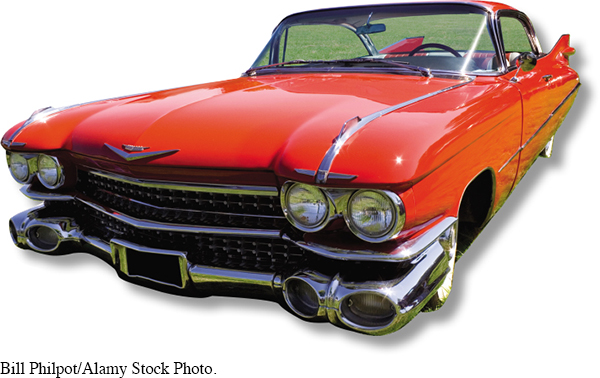The American Promise: Printed Page 771
The American Promise, Value Edition: Printed Page 700
The American Promise: A Concise History: Printed Page 798
Introduction to Chapter 27
The American Promise: Printed Page 771
The American Promise, Value Edition: Printed Page 700
The American Promise: A Concise History: Printed Page 798
Page 77127
The Politics and Culture of Abundance
1952–

CONTENT LEARNING OBJECTIVES
After reading and studying this chapter, you should be able to:
Explain the major issues of the Eisenhower administration and how Eisenhower’s approach represented the politics of the “Middle Way.”
Describe how the Eisenhower administration practiced containment and explain how the “New Look” in foreign policy influenced its handling of world events.
Explain the factors that led to an economy of abundance and how that abundance influenced Americans’ lives.
Analyze how the economy of abundance influenced consumption, religion, gender roles, and the media.
Explain the origins of the modern civil rights movement and the strategies activists used to end racial segregation.
TRAILED BY REPORTERS, VICE PRESIDENT RICHARD M. NIXON LED Soviet premier Nikita Khrushchev through the American National Exhibition in Moscow in July 1959. The display of American consumer goods was part of a cultural exchange that reflected a slight thaw in the Cold War after Khrushchev replaced Stalin. In Moscow, both Khrushchev and Nixon seized on the propaganda potential of the moment. As they examined the display, they exchanged a slugfest of words and gestures that reporters dubbed the kitchen debate.
Showing off a new color television set, Nixon said that the Soviet Union “may be ahead of us . . . in the thrust of your rockets,” but he insisted that the United States outstripped the Soviets in consumer goods. Nixon linked capitalism with democracy, asserting that the array of products represented “what freedom means to us . . . our right to choose.” Moreover, Nixon boasted that “any steelworker could buy this house,” as the two leaders walked through a model of a six-
Nixon declared that the household appliances were “designed to make things easier for our women.” Khrushchev disparaged “the capitalist attitude toward women,” maintaining that the Soviets appreciated women’s contributions to the economy, not their domesticity. Nixon got Khrushchev to agree that it was “far better to be talking about washing machines than machines of war,” yet Cold War tensions surfaced when Khrushchev later blustered, “We too are giants. You want to threaten—
The American Promise: Printed Page 771
The American Promise, Value Edition: Printed Page 700
The American Promise: A Concise History: Printed Page 798
Page 772
In fact, the Eisenhower administration (1953–
Continuity with the Truman administration also characterized domestic policy. Although Eisenhower favored corporations with tax cuts and resisted strong federal efforts in health care, education, and race relations, he did not try to demolish the New Deal. He even extended the reach of the federal government with a massive highway program.
Although poverty clung stubbornly to one of every five Americans, the Moscow display testified to the unheard-
The Cold War and the economic boom helped African Americans mount the most dramatic challenge of the 1950s, a struggle against the system of segregation and disfranchisement that had replaced slavery. Large numbers of African Americans took direct action against the institutions of injustice, developing the organizations, leadership, and strategies to mount a civil rights movement of unprecedented size and influence.
CHRONOLOGY
| 1952 |
|
| 1953 |
|
| 1954 |
|
| 1955 |
|
| 1955– |
|
| 1956 |
|
| 1957 |
|
| 1958 |
|
| 1959 |
|
| 1960 |
|